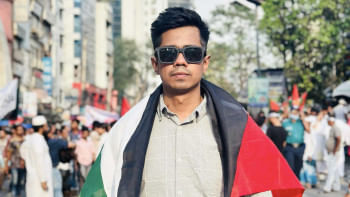COP26 and its relevance to Bangladesh’s apparel industry

The 26th UN Climate Change Conference (COP26) started last week in Glasgow, Scotland. Bangladesh, appropriately, is being represented at the global climate event by a delegation from the Bangladesh Garment Manufacturers and Exporters Association (BGMEA), led by President Faruque Hassan. The goals of COP26 are, after all, pertinent where the global apparel industry and its supply chains are concerned.
So what is COP26 all about? What are its actual aims, and why are events in the UK this week relevant to Bangladesh's apparel industry?
COP26 sets four overriding goals, which are pertinent to us as apparel makers. The goals are: a) To secure global net zero emissions by mid-century and keep the global temperature rise under 1.5 degrees Celsius, in line with the Paris Agreement; b) To adapt and protect communities and natural habitats; c) To mobilise finance; and d) To work together to deliver (partnerships).
The first goal is highly relevant to garment supply chains. Every major fashion brand has set targets around carbon emission reductions, and these are aligned with the targets set out in the Paris Agreement. It is to be noted that many of our customers are in Glasgow this week.
To achieve greenhouse gas (GHG) reduction goals, the fashion industry needs to work closely in collaboration with its suppliers. This includes supporting supply chains in the shift towards the use of renewable energy as well as better, more efficient technologies. It also entails, at a broader level, phasing out "dirty" energy from the industry, including coal (which, thankfully, the RMG sector in Bangladesh is not heavily dependent on compared to some of its competitors).
The net-zero goal is also relevant for our RMG sector. As the saying goes: "You can't do business on a dead planet." COP26 and its focus on the mitigation of human-induced GHG emissions has major implications for climate vulnerable economies, such as Bangladesh. Our industry leaders have more reason than most to keep a close eye on the developments in Glasgow, and hope that the world leaders in attendance will deliver on their climate promises.
The second goal, which is to adapt and protect communities and natural habitats, includes protecting and restoring ecosystems, and building resilient infrastructure and agricultural systems to avoid the loss of homes, livelihoods, and even lives.
It is commonly stated that fashion is one of the most polluting industries in the world. Much of the reason behind that is the supply chains, which are dependent on the use of dyes and chemicals, as well as the application of potentially polluting industrial processes.
It has become apparent that the climate is already changing, and ecosystems are being disrupted to an alarming degree.
In the apparel sector, we can do our part by moving towards the use of best available technologies in areas such as wastewater treatment. This will enable us to limit the flow of potentially harmful chemicals into our rivers and waterways. We can also shift towards less wasteful production methods, which create excessive textile waste for the environment. Investment in new technologies and shifts towards recycling are the key moves here.
This brings us to the third COP26 goal, which is mobilising finance. To deliver on our first two goals, the leaders of COP26 have called on developed countries to mobilise at least USD 100 billion in climate finance per year. They also suggest that the international financial institutions play their part in helping to channel trillions of dollars in private and public sector finance required to secure global net zero emissions.
This is why it is so important that the key movers and shakers of Bangladesh's economy are in Glasgow. They have to make the case for Bangladesh as a green investment hub. Supply chains are critical where emissions are concerned, but suppliers do not have the finance to do this on their own. They need support from their buyers, governments and the global investment community to implement new technologies and different ways of working.
I would like to see COP26 as a catalyst for Bangladesh's garment sector to further its cause as a worthy hub for grant and other funding from the likes of the World Bank, the International Finance Corporation (IFC) and other global financial institutions which, working in collaboration with multinational retailers, can help bring about genuine change in our industry.
The final goal is partnership. "Work together to deliver" is the message of COP26, the argument being that we can only rise to the challenges of the climate crisis by working collaboratively. But are we all ready to embrace this new, collaborative way of working in garment supply chains?
So far, I have seen some examples of this, but to be honest, the old adversarial approach to buyer-supplier relations is still evident across swathes of the industry. If we genuinely want COP26 to be the agent of change it surely needs to be, collaboration and partnership between apparel buyers and suppliers are a key to success. Only this can ensure a fashion industry we can all be proud of, and from which we can all continue to prosper.
Mostafiz Uddin is the managing director of Denim Expert Limited, and the founder and CEO of Bangladesh Apparel Exchange (BAE) and Bangladesh Denim Expo.

 For all latest news, follow The Daily Star's Google News channel.
For all latest news, follow The Daily Star's Google News channel. 



Comments